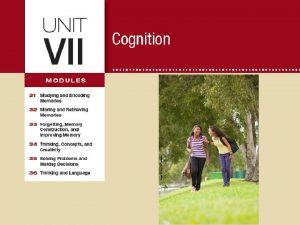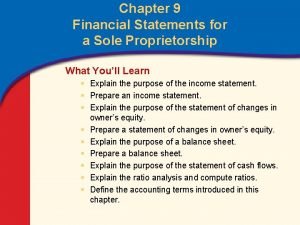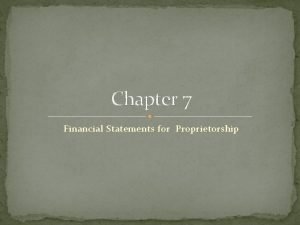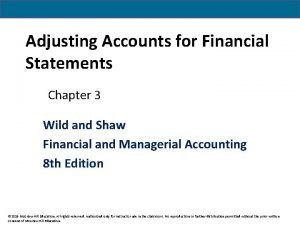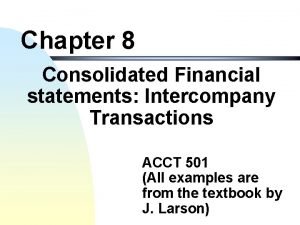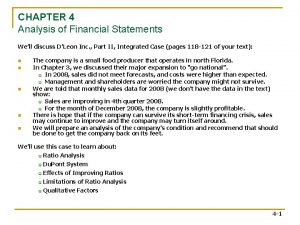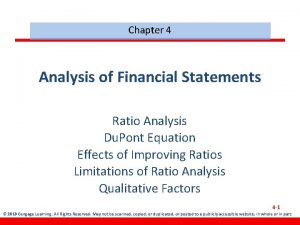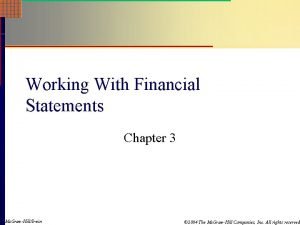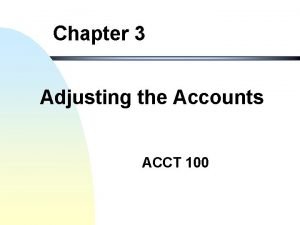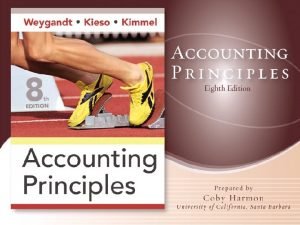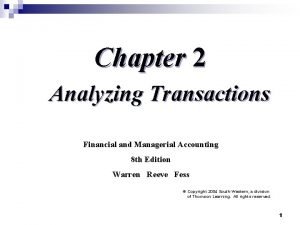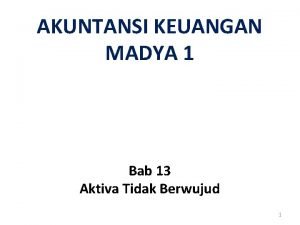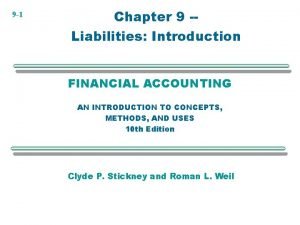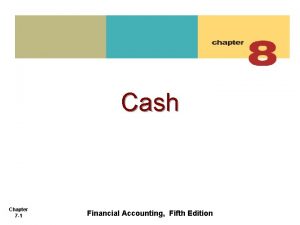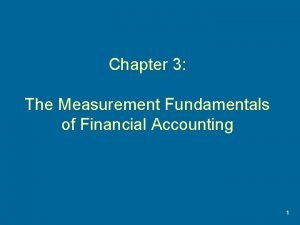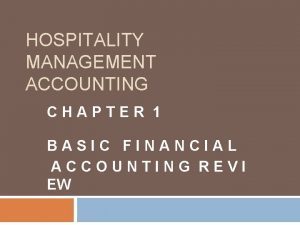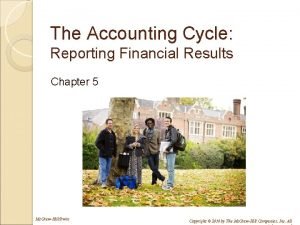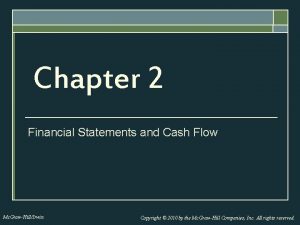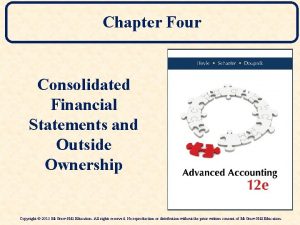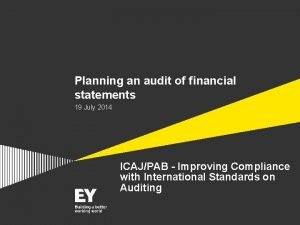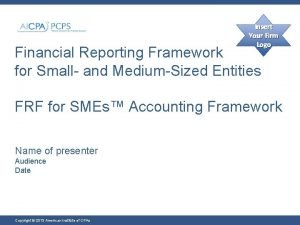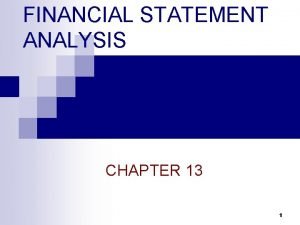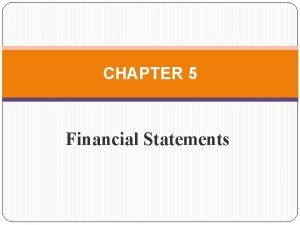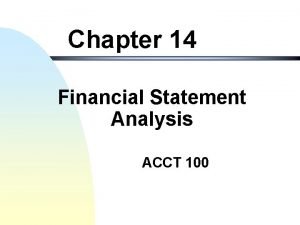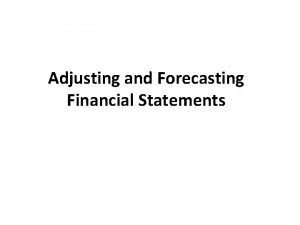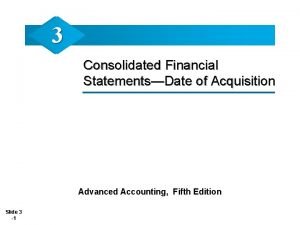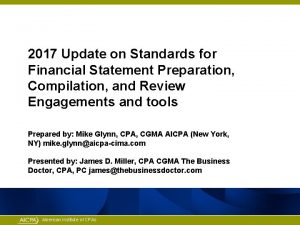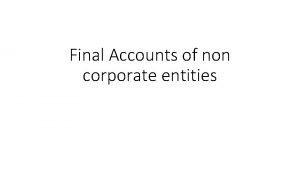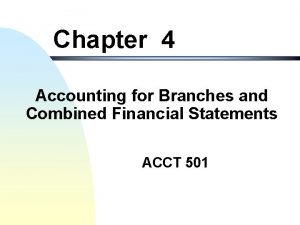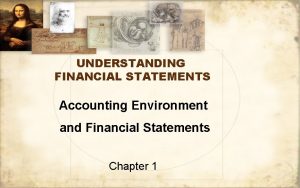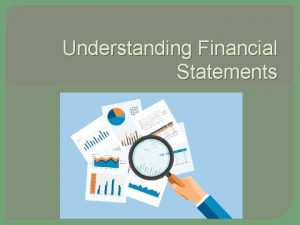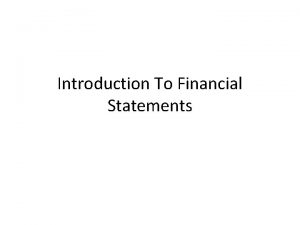CHAPTER EIGHTEEN UNDERSTANDING ACCOUNTING AND FINANCIAL STATEMENTS Text














































- Slides: 46

CHAPTER EIGHTEEN UNDERSTANDING ACCOUNTING AND FINANCIAL STATEMENTS Text by Profs. Gene Boone & David Kurtz Multimedia Presentation by Prof. Milton Pressley The University of New Orleans milton. pressley@uno. edu Copyright © 2003 by South-Western. All Rights Reserved.

LEARNING GOALS • • Explain the functions of accounting and its importance to the firm’s management, investors, creditors, and government agencies Identify the three basic activities involving accounting Describe the roles played by public, management, government, and not-for-profit accountants Outline the steps in the accounting process Copyright © 2003 by South-Western. All Rights Reserved.

LEARNING GOALS • • Explain the functions and major components of the three principal financial statements: the income statement, the balance sheet, and statement of cash flows Discuss how financial ratios are used to analyze the firm’s financial strengths and weaknesses Describe the role of budgets in a business Explain how exchange rates influence international accounting practices and the importance of uniform financial statements for global business Copyright © 2003 by South-Western. All Rights Reserved.

CHAPTER OVERVIEW • Accounting: practice of measuring, interpreting, and communicating financial information to support internal and external business decision making © Photo. Disc Copyright © 2003 by South-Western. All Rights Reserved.

CHAPTER OVERVIEW • This chapter: • Describes who uses accounting information • Discusses financing, investing, and • • operating Explains the accounting process Discusses the development of accounting statements from information about financial transactions Presents the methods of interpreting these statements Examines the role of budgets in planning and controlling for a business © Photo. Disc Copyright © 2003 by South-Western. All Rights Reserved.

USERS OF ACCOUNTING INFORMATION • People both inside and outside and organization rely on accounting information to help them make business decisions © Photo. Disc Copyright © 2003 by South-Western. All Rights Reserved.

Figure 18. 1 Users of Accounting Information Copyright © 2003 by South-Western. All Rights Reserved.

ACCOUNTING AND THE ENVIRONMENTS OF BUSINESS • Accountants contribute important • information to help managers deal with the competitive and economic environments They help others to understand, predict, and react to the technological, regulatory, and social and cultural environments © Photo. Disc Copyright © 2003 by South-Western. All Rights Reserved.

BUSINESS ACTIVITIES INVOLVING ACCOUNTING • Accounting plays a key role in: • Financing • Investing • Operating © Photo. Disc Copyright © 2003 by South-Western. All Rights Reserved.

ACCOUNTING PROFESSIONALS • Public accountant: • provides accounting services to individuals or business firms for a fee Most commonly provided services provided by accountants: • Auditing • Tax planning and preparation • Management consulting © Photo. Disc Copyright © 2003 by South-Western. All Rights Reserved.

Figure 18. 2 Accounting Firms Do More Than Just Prepare Financial Statements Copyright © 2003 by South-Western. All Rights Reserved.

ACCOUNTING PROFESSIONALS • Management accountant: accountant employed by a business other than a public accounting firm • Responsible for collecting and recording financial transactions, and preparing and interpreting financial statements used by the firm’s managers © Photo. Disc Copyright © 2003 by South-Western. All Rights Reserved.

ACCOUNTING PROFESSIONALS • Government and Not-for-Profit • accountants: work for federal, state, and local governments or not-for-profit organizations – perform professional services similar to those of management accountants Instead of an emphasis on measuring profit or loss, they concern themselves with determining how efficiently the organizations accomplish their objectives © Photo. Disc Copyright © 2003 by South-Western. All Rights Reserved.

THE ACCOUNTING PROCESS • Accounting process: the set of activities involved in converting data about individual transactions to financial statements © Photo. Disc Copyright © 2003 by South-Western. All Rights Reserved.

Figure 18. 3 the Accounting Process Copyright © 2003 by South-Western. All Rights Reserved.

The Impact of Computers and the Internet on the Accounting Process • Has simplified the process, making • it faster and easier than the manual method Accounting software allows: • • • A do-it-once approach Numbers can be easily converted into graphs and charts Other automatic conversion © Photo. Disc Copyright © 2003 by South-Western. All Rights Reserved.

The Impact of Computers and the Internet on the Accounting Process • The internet has brought about: • Web-based accounting products • designed for small business Outsourced, Web-based bookkeeping and accounting services © Photo. Disc Copyright © 2003 by South-Western. All Rights Reserved.

Figure 18. 4 Web-Based Accounting Services Copyright © 2003 by South-Western. All Rights Reserved.

THE FOUNDATION OF THE ACCOUNTING SYSTEM • Generally Accepted Accounting • Principles (GAAP): guidelines, or standards, that accountants follow to provide reliable, consistent, and unbiased information to decision makers Financial Accounting Standards Board (FASB): responsible for evaluating, setting, or modifying the GAAP © Photo. Disc Copyright © 2003 by South-Western. All Rights Reserved.

The Accounting Equation • Asset: anything of value owned or leased by a business • Includes land, buildings, supplies, cash, accounts or notes receivable, and marketable securities © Photo. Disc Copyright © 2003 by South-Western. All Rights Reserved.

The Accounting Equation • Liability: a claim against a firm’s assets by a creditor • Includes accounts payable, notes payable, wages payable and long-term debt © Photo. Disc Copyright © 2003 by South-Western. All Rights Reserved.

The Accounting Equation • Owners’ equity: all claims of the proprietor, partners, or stockholders against the assets of a firm, equal to the excess of assets over liabilities © Photo. Disc Copyright © 2003 by South-Western. All Rights Reserved.

The Accounting Equation • Accounting equation: states that Assets = Liabilities + Owner’s Equity © Photo. Disc Copyright © 2003 by South-Western. All Rights Reserved.

FINANCIAL STATEMENTS Balance sheet • Balance sheet: statement of a firm’s financial position – what it owns and the claims against its assets -- at a particular time • Similar to a photograph of the firm’s assets together with its liabilities and owners’ equity at a specific moment in time Copyright © 2003 by South-Western. All Rights Reserved.

Figure 18. 5 Balance Sheet for Sierra Pasta Company Copyright © 2003 by South-Western. All Rights Reserved.

FINANCIAL STATEMENTS Balance sheet Income statement • Income statement: a financial record of a company’s revenues, expenses, and profits over a period of time • It helps decision makers to focus on the overall revenues and costs involved in generating them Copyright © 2003 by South-Western. All Rights Reserved.

Figure 18. 6 Income Statement for Sierra Pasta Company Copyright © 2003 by South-Western. All Rights Reserved.

FINANCIAL STATEMENTS Balance sheet Income statement • Statement of cash flows: statement of a firm’s cash receipts and cash payments that present information on its sources and uses of cash Statement of cash flows Copyright © 2003 by South-Western. All Rights Reserved.

Figure 18. 7 Statement of Cash Flows for Sierra Pasta Company Copyright © 2003 by South-Western. All Rights Reserved.

FINANCIAL STATEMENTS Balance sheet Income statement • Accrual accounting: accounting method that records revenues and expenses when they occur, not necessarily when cash actually changes hands Statement of cash flows Copyright © 2003 by South-Western. All Rights Reserved.

FINANCIAL RATIO ANALYSIS Liquidity ratios • Profitability ratios Leverage ratios Activity ratios • Ratio analysis: one of the most commonly used tools for measuring the firm’s liquidity, profitability, and reliance on debt financing, as well as the effectiveness of management’s use of its resources Allows comparisons with other firms and with the firm’s own past performance © Photo. Disc Copyright © 2003 by South-Western. All Rights Reserved.

Copyright © 2003 by South-Western. All Rights Reserved.

FINANCIAL RATIO ANALYSIS • Firm’s ability to meet its Liquidity ratios • short-term obligations when they must be paid is measured by liquidity ratios Current ratio and acidtest ratio are two commonly used liquidity ratios © Photo. Disc Copyright © 2003 by South-Western. All Rights Reserved.

FINANCIAL RATIO ANALYSIS Liquidity ratios • Current ratio: compares current assets to current liabilities • Gives managers information about the firm’s ability to pay its current debts as they mature © Photo. Disc Copyright © 2003 by South-Western. All Rights Reserved.

FINANCIAL RATIO ANALYSIS • Acid-test (or quick) ratio: Liquidity ratios compares quick assets – the most current liquid assets – against current liabilities • • Quick assets generally consist of cash and marketable securities, and accounts receivable Measures the ability of the firm to meet its debt payments on short notice © Photo. Disc Copyright © 2003 by South-Western. All Rights Reserved.

FINANCIAL RATIO ANALYSIS Liquidity ratios Profitability ratios • Profitability ratios: • compare the firm’s earnings with total sales or investments Over time, may reveal the effectiveness of management in operating the business © Photo. Disc Copyright © 2003 by South-Western. All Rights Reserved.

FINANCIAL RATIO ANALYSIS Liquidity ratios Profitability ratios • Five important profitability ratios are: • Gross profit margin • Net profit margin • Earnings per share • Return on assets • Return on equity © Photo. Disc Copyright © 2003 by South-Western. All Rights Reserved.

FINANCIAL RATIO ANALYSIS Liquidity ratios Profitability ratios Leverage ratios • Leverage ratios: • measures the extent to which a firm relies on debt financing Provide particularly interesting information to potential investors and lenders © Photo. Disc Copyright © 2003 by South-Western. All Rights Reserved.

FINANCIAL RATIO ANALYSIS Liquidity ratios Profitability ratios • Activity ratios: measure the effectiveness of management’s use of the firm’s resources Leverage ratios Activity ratios © Photo. Disc Copyright © 2003 by South-Western. All Rights Reserved.

FINANCIAL RATIO ANALYSIS Liquidity ratios • Inventory turnover Profitability ratios Leverage ratios Activity ratios • ratio: indicates the number of times merchandise moves through a business Total asset turnover: measures how much in sales each dollar in assets generates © Photo. Disc Copyright © 2003 by South-Western. All Rights Reserved.

BUDGETING • Budget: • • • a planning and controlling tool that reflects the firm’s expected sales revenues, operating expenses, and cash receipts and outlays Quantifies the firm’s plans for a specified future period Serves as a financial blueprint Standard for comparison against actual performance © Photo. Disc Copyright © 2003 by South-Western. All Rights Reserved.

Figure 18. 8 Sample Cash Budget for Sierra Pasta Company Copyright © 2003 by South-Western. All Rights Reserved.

INTERNATIONAL ACCOUNTING • Accounting procedures and practices must be adapted to accommodate an international business environment © Photo. Disc Copyright © 2003 by South-Western. All Rights Reserved.

Exchange Rates • Exchange rate: • the ratio at which a country’s currency can be exchanged for other currencies Currency prices change daily according to supply and demand • Such fluctuations complicate accounting entries and practices © Photo. Disc Copyright © 2003 by South-Western. All Rights Reserved.

International Accounting Standards • International Accounting Standards • Committee (IASC), established in 1973, promotes worldwide consistency in financial reporting practices Every five years, an international congress is held to: • Judge progress in achieving consistency in • standards Work toward increasing comparability among nations’ financial data and currencies © Photo. Disc Copyright © 2003 by South-Western. All Rights Reserved.

WHAT’S AHEAD • In next chapter, the financing • function of an organization will be introduced Finance deals with planning, obtaining, and managing the organization funds to accomplish its objective in the most efficient and effective manner possible © Photo. Disc Copyright © 2003 by South-Western. All Rights Reserved.
 Intermediate accounting chapter 1
Intermediate accounting chapter 1 Unit 13 accounting and financial statements
Unit 13 accounting and financial statements How did daisy react after gatsby left for military service
How did daisy react after gatsby left for military service Module 36 thinking and language
Module 36 thinking and language What is an example of a text-to-media connection?
What is an example of a text-to-media connection? Investment center
Investment center Financial statements and ratio analysis chapter 3
Financial statements and ratio analysis chapter 3 Financial statements and ratio analysis chapter 3
Financial statements and ratio analysis chapter 3 Chapter 2 financial statements taxes and cash flow
Chapter 2 financial statements taxes and cash flow Fees earned debit or credit
Fees earned debit or credit Chapter 9 financial statements for a sole proprietorship
Chapter 9 financial statements for a sole proprietorship Sole proprietorship financial statements
Sole proprietorship financial statements Adjusting accounts for financial statements chapter 3
Adjusting accounts for financial statements chapter 3 Intercompany bond transactions
Intercompany bond transactions Chapter 4 analysis of financial statements
Chapter 4 analysis of financial statements Chapter 4 analysis of financial statements
Chapter 4 analysis of financial statements Working with financial statements chapter 3
Working with financial statements chapter 3 Chapter 3 adjusting accounts for financial statements
Chapter 3 adjusting accounts for financial statements Adjusting entry accrued expense
Adjusting entry accrued expense Managerial accounting chapter 2 solutions
Managerial accounting chapter 2 solutions Financial accounting chapter 13
Financial accounting chapter 13 Accounting chapter 6
Accounting chapter 6 Financial accounting chapter 9
Financial accounting chapter 9 Financial accounting chapter 7
Financial accounting chapter 7 Financial accounting ifrs 4th edition chapter 12
Financial accounting ifrs 4th edition chapter 12 Financial accounting chapter 3
Financial accounting chapter 3 Owner's equity statement
Owner's equity statement Hospitality management accounting
Hospitality management accounting Financial accounting chapter 5
Financial accounting chapter 5 Cash flow to creditors is equal to
Cash flow to creditors is equal to Commercial bank income statement
Commercial bank income statement Consolidated financial statements and outside ownership
Consolidated financial statements and outside ownership Financial plan elements
Financial plan elements Audit planning memorandum ey
Audit planning memorandum ey Sample notes to financial statements for small entities
Sample notes to financial statements for small entities Chapter 13 financial statement analysis
Chapter 13 financial statement analysis Financial statements translation
Financial statements translation Chapter 6 fge financial management
Chapter 6 fge financial management Acct 100
Acct 100 Parsimonious method of forecasting
Parsimonious method of forecasting Consolidated financial statements date of acquisition
Consolidated financial statements date of acquisition Ssars 21 preparation of financial statements
Ssars 21 preparation of financial statements Cost effectiveness constraint
Cost effectiveness constraint Ias 27
Ias 27 Standardized income statement
Standardized income statement What are non corporate entities
What are non corporate entities Branch financial statements
Branch financial statements



